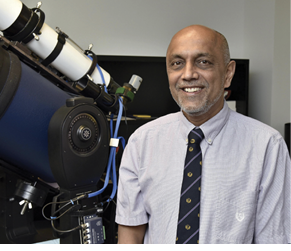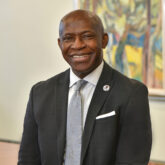A primary thread in that fabric is the constant, interwoven involvement of successful Oswego alumni teachers and school administrators. Pat Russo ’72 M’79 CAS ’85, director of the Center for Urban Schools, said, “It’s important to remember that alumni contribute to their alma mater in very concrete ways every year as they host our candidates.”
Oswego’s education degree candidates student-teach in schools with diverse populations, where they learn to integrate theory with practice, an attribute of Oswego’s program that dates back to the Normal School and, ultimately, to Oswego’s founder, Edward Austin Sheldon.
Liverpool technology teacher Karin M. Dykeman ’91 M’99 sees her mentorship as a matter of scale in her quest to improve the universal quality of life. “Clearly, rather than acting alone, I have a broader positive influence by helping student-teachers be dynamic, caring professionals,” she said. “Through them, I can indirectly influence more young people to change the world for the better.”
Dykeman also views her commitment as a means of taking her place in the long line of graduates reaching out to Oswego students.
“Mentoring is an important professional obligation,” she said. “I was fortunate to be mentored by Gerald Kranz ’61 and Donna Matteson ’83 M’88. They modeled high standards of professionalism, school and community engagement, instructional innovation and lifelong learning. I benefitted. Consequently, my students have benefitted. Now, it’s my turn to do the same for others.”
Alumni: An Essential Strand
Pamela Michel, dean, celebrates alumni who are already successful in their teaching careers for mentoring aspiring teachers, providing valuable support by sharing experiences and expertise. She notes the success of innovative Oswego programs such as the TESOL Bridges, Oswego’s intensive full-time teaching residency program focused on teaching English to speakers of other languages, and the MAT, in which candidates for the Master of Arts in Teaching complete graduate coursework and, simultaneously, participate in intensive classroom residencies. Host teachers who participate in these, and other successful programs, view this contribution to their alma mater as a positive experience for all involved.
Syracuse’s Fowler High School math teacher Jake Taylor ’08 said it’s a privilege to give back to the college where he received positive support from outstanding faculty members. “Working with SUNY Oswego in its clinically rich approach, I was impressed with the preparation and readiness of the teacher candidates I hosted,” he said.
Pupils in classes taught by Oswego alumni and teacher candidates ultimately benefit from having two teachers for an academic year. “Data from my classroom shows positive and encouraging results,” ESL teacher Holly Henderson Ashcraft ’09 said. “The variety of how content, ideas and techniques are presented from both teachers has given the children multiple ways to process and interact with the English language.”
Dean Michel explains that student-teaching is a deeply rooted method of teacher preparation at Oswego. But clinically rich programs—those in which education students are immersed in all aspects of classroom experiences—expand upon the longstanding diverse partnerships with schools in this region and across the state, resulting in classroom placements that last longer, involve students more fully and create greater symbiotic relationships.
“I’ve been able to repay SUNY Oswego for preparing me to be the educator that I have become,” Fowler High School ESL teacher Chelsey MacDougall ’09 said. “The two students I have worked with in the clinically rich program … have made me consider more ways to improve my own practice.”
Oswego Middle School Assistant Principal Robyn Proud ’87 M’98 CAS ’11, who hosted practicum students and teacher candidates from her alma mater over a period of 12 years, praises the clinically rich model.
Learning Communities Interwoven
“The partnership with SUNY Oswego joins two learning communities together,” Proud said. “The college student and the middle school students benefit from the relationships. I have had a positive experience using the model. I am still in touch with many of my former student teachers, and I often collaborate with them during their first years of teaching.”
“The interaction between alumni and current students provides opportunities for candidates to learn about diverse social, cultural and theoretical perspectives,” Michel said. “These programs build on Oswego’s legacy as a fount of excellence in teacher preparation. When alumni reach out to current students, they join together to weave Oswego’s successful past into its vibrant and effective future.”
“I take student-teachers from my alma mater because of Oswego’s longstanding traditions in education. Oswego remains focused on quality teaching and learning, just as Edward Austin Sheldon promoted more than 150 years ago.”
Don Little ’91 M’94
Nottingham High School, social studies teacher, Syracuse, N.Y.

“I hosted a student teacher from the TESOL program, and it was a learning experience for me as well. As education is an ever-changing field, I think it is vital that we all continue to learn and build our repertoires.”
Katie Blanding Knapp ’08 M’11
Morgan Road Elementary, ESL Teacher, Liverpool, N.Y.
“Teaching at Proctor High School might have seemed daunting because of the size of the school, the diverse student population and its urban atmosphere. With the support of the SUNY Oswego clinically rich environment and the rigorous protocol of the preparatory program, my student-teacher excelled, and we both had a successful experience.”
Deborah Palaka M’04
Proctor High School, Biology Teacher, Utica, N.Y.
“My SUNY Oswego education prepared me to teach the students of the future. I had great mentors along the way. That is why I give back to the college by taking student-teachers, too. I feel that it is essential for new teachers to understand what they are up against and that our profession is among the most important careers in America.”
Brad DePoint ’05
J.E. Lanigan Elementary School, 6th Grade Teacher, Fulton, N.Y.
About the School of Education
Founded: 1861
Leadership: Dr. Pamela Michel, dean
Faculty: 70 full-time faculty in six departments
Students: ~1,650 (1,250 undergraduates; 400 graduate)
Departments:
- Counseling and Psychological Services
- Curriculum and Instruction
- Educational Administration
- Health and Wellness Promotion
- Technology
- Vocational Teacher Preparation
Field Placements: More than 1,200 placements in 300 schools/agencies each academic year.
Facilities:
- Park Hall: Named for industrial arts professor and scholar Joseph C. Park, Class of 1902, the building recently received a two-year, $17.5 million modernization, including a new roof, mechanical systems, sprinkler system, windows, high-tech flexible classrooms, a webinar room, fully renovated transportation lab and a new south-facing main entrance. The entrance and atrium with three levels
of walkways connects to the school’s adjacent Wilber Hall and, through it, the Shineman Center.- Wilber Hall: Recent $5.8 million, 13,700-square-foot addition houses two glass-walled, state-of-the-art labs for wood production and polymers and the school’s field placement office.
Accreditation: National Council for Accreditation of Teacher Education (soon to be CAEP, Council for the Accreditation of Educator Preparation)
Points of Distinction:
- 75 years hosting the Tech Conference
- 37 years hosting the Sheldon Institute summer enrichment program
- 10-plus years running the Project SMART, Science and Math Applied Resources for Teaching professional development program
- Team Sheldon, partnership with Oswego County public schools and Oswego County BOCES
- Educational Leadership Institute, International Professional Achievement Academy, Reading Clinics, Professional Development Workshops, Writing Institutes, Onondaga Nation Partnership
Vision Statement Excerpt: The School of Education fosters a vibrant intellectual community that values teaching, collaboration and scholarship, as well as promotes and supports socially just policies and practices.
Mission Statement Excerpt: We will instruct, involve, challenge and care for all learners, children and adults, in the legacy of Edward Austin Sheldon.
More from Faculty
Physics Professor Shashi Kanbur Earns SUNY Distinguished Professor Rank
Physics Professor Shashi Kanbur Earns SUNY Distinguished Professor Rank A record of astronomical research accomplishments and providing stellar opportunities for students …
Faculty Member Publishes Breakthrough Research on Bird Migration
Faculty Member Publishes Breakthrough Research on Bird Migration Daniel Baldassarre, a SUNY Oswego biological science faculty member, recently published research that …
Student-Faculty Team Publishes Study on Invasive Species
Student-Faculty Team Publishes Study on Invasive Species The work of four SUNY Oswego student researchers and a faculty member tracking and …














